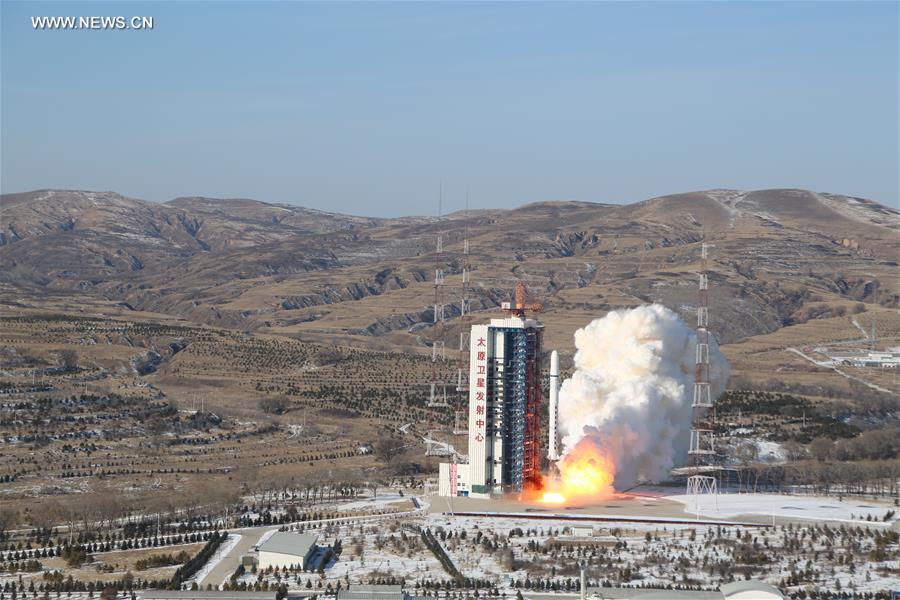China's potential as a mature spacefaring nation
- By Richard de Grijs
 0 Comment(s)
0 Comment(s) Print
Print E-mail China.org.cn, December 29, 2016
E-mail China.org.cn, December 29, 2016
|
|
| A Long March 2D rocket carrying a pair of 0.5-meter high-resolution remote sensing satellites, SuperView-1 01/02, blasts off from the launch pad at the Taiyuan Satellite Launch Center in north China's Shanxi Province, Dec. 28, 2016. [Photo/Xinhua] |
On Tuesday, the State Council Information Office issued its long-awaited White Paper on Chinese space development. The comprehensive document offers a snapshot of Chinese civilian space activity in 2016, looking back at its achievements since the publication of the previous white paper in 2011 and outlining plans for the next five years. As expected, much of the document's focus is on peaceful economic development.
The document is meant to demonstrate that the country's technological development and space prowess have progressed rapidly since the launch of its first satellite, Dongfanghong I, on April 24, 1970. That first mission's sole remit was to broadcast the song "Dong Fang Hong" (The East is Red) and announce the time during its 20 days of active in-orbit operation. In four decades, China has become an ambitious spacefaring nation with access to an impressive launch vehicle, Long March 5 (CZ-5), which can lift some 25 tons to low earth orbit or up to 14 tons to the type of geostationary orbit suitable for stable satellite communications purposes, significantly more than the 173 kg lifted by Dongfanghong I's Long March 1 rocket.
Yet, Chinese space development has not proceeded in isolation. The United States and Russia, as well as the European nations collaborating under the umbrella of the European Space Agency, have similarly developed mature space technology, each with their own strengths and weaknesses. The Soviet Union's first successful launch, that of Sputnik I, preceded China's Dongfanghong I by more than 12 years, while the Americans launched their own first unmanned space mission, Explorer I, only half a year after their Soviet competitors. It stands to reason, therefore, that China's maturing space program might benefit from international collaboration.
Development of cutting-edge space technology is fiercely competitive and potentially highly lucrative, however, so few details are provided in the White Paper. Space science, and particularly deep-space exploration, has fewer commercial strings attached, meaning international collaboration in these areas is more likely to develop. Other than the Chang'e series of Moon probes, China's foray into deep-space exploration has only just taken off: Its first scientific satellite, the Dark Matter Particle Explorer (DAMPE) was launched as recently as December 2015.
The White Paper highlights tangible mission proposals that may get the green light to proceed to the development phase in the next five years. Preparation of space missions takes time and significant, long-term investment. The country's senior leadership clearly understands these issues; it is striking, however, that bilateral development efforts with NASA are almost non-existent. China–U.S. collaborations proposed in the White Paper do not go beyond risk and hazard reduction programs, including those related to space debris, space weather and coordinated responses to global climate change. This is unfortunate, since access to the vast experience their U.S. counterparts might contribute could greatly benefit Chinese space scientists and engineers, without jeopardizing alleged U.S. security interests.
However, sustained lobbying by Frank Wolf, former member of the U.S. House of Representatives, led the U.S. Congress to adopt the so-called "Wolf amendment" in 2011, prohibiting the use of any federal funding for bilateral participation, collaboration or coordination with Chinese citizens affiliated with Chinese institutions. Although this legislation has been challenged repeatedly in recent years, it is unlikely that the incoming U.S. administration under President-elect Trump will repeal it any time soon.
While this state of affairs will undoubtedly drive Chinese space scientists to collaborate with international counterparts that are more open to the free exchange of ideas and coordinated development efforts, the U.S. administration's stance appears counterproductive and potentially hazardous in fostering the peaceful development of outer space. Indeed, close collaboration on space missions – and even space rescue efforts such as that portrayed in the 2015 blockbuster "The Martian" – seems a long way off and, in the present political climate at least, practically unrealistic.
It is therefore encouraging to see that the White Paper sets out a clear vision for the sustained development of China's space technology and of its goals in pursuing space science. International collaboration in areas related to unmanned space exploration – in astronomy, remote sensing, environmental and climate science, the life sciences, space weather and plasma physics – is here to stay, irrespective of the political landscape prevailing elsewhere. Collaboration rather than isolation will be of greater benefit to the planet as a whole. China's civilian space program has the potential to meaningfully contribute to this vision.
Richard de Grijs is a Dutch professor of astrophysics at the Kavli Institute for Astronomy and Astrophysics (Peking University) in Beijing. He is also Discipline Scientist at the International Space Science Institute–Beijing, which was established specifically to foster international collaboration in space science.






